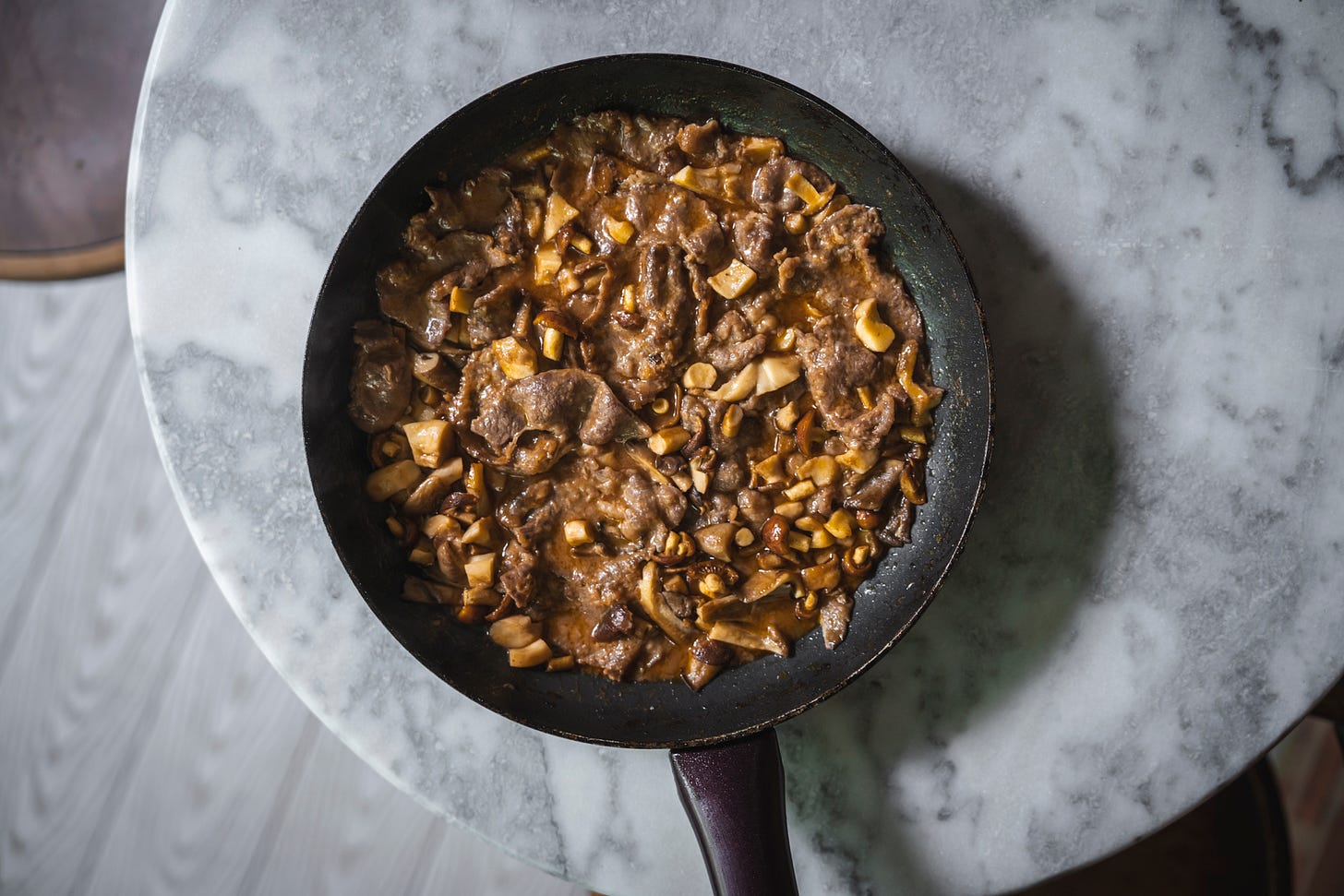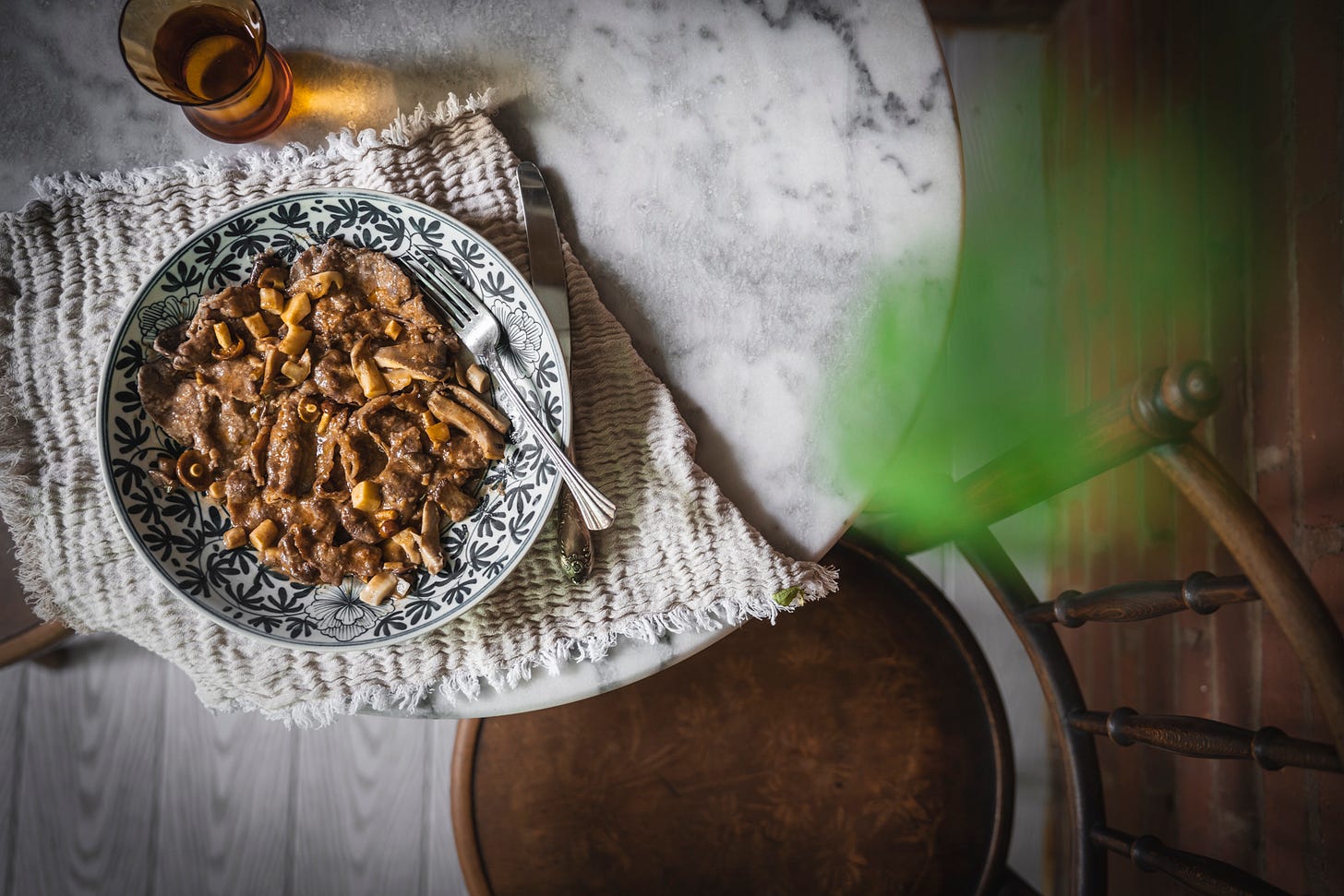When the air starts smelling of fall, Catalans get excited for a very specific thing: seasonal mushrooms. Many go search for the fungi themselves in what’s known as caçar bolets (“mushroom hunting”) and even if you don’t, most of us love seeing all the wild foraged mushrooms featured in restaurants’ menus.
Here in the US foraged mushrooms are yet to become as popular as they are in Catalonia. There’s still a certain fear of eating the wrong kind of mushroom and suffer the consequences, so it’s almost impossible to get hold of them unless you forage them yourself. As I couldn’t find any, I bought a mix of farmed mushrooms from my local farmer's market.
I have been longing for this dish since the start of the month. Seeing the leafs on the floor and the trees turning color was an indicator of autumnal dishes to come. So I thought I’d share this beloved family recipe with you.
Fricandó may come from the Occitan word frica which is an evolution of frigere (“to fry” in Latin). In the Occitan area of France there’s also a dish called fricandeau, but in this case it consists of pork meatballs. While in the rest of the country the name refers to a big cut of beef that is cooked whole and served stuffed with bacon.
In Catalonia fricandó is a very different preparation. It consists of braised beef (traditionally is always veal) cooked in a thick sauce of onions, tomato and broth and finished off with moixernons (St. George’s mushrooms). In medieval times we already find a former relative: vedella amb sosengua (veal with a thick sauce containing many ingredients - onion, bread, honey, vinegar, broth, eggs…-). It didn’t have tomatoes, which where incorporated after the columbian exchange. The recipe as we know it now appeared for the first time in the cookbook Avisos y instrucciones per lo principiant cuiner (XIX century) and it has been shaped by each family ever since.
I called my mum to hear how she makes it. I’ve eaten it multiple times at my family home but I never paid enough attention. This time, I was taking notes. We video called and she walked me though the steps, getting annoyed when I asked for measurements, as she always cooks “by eye”. I stopped bothering with quantities and asked instead for visual cues.
She doesn’t make a picada (a Catalan technique to thicken sauces that incorporates almonds), because with the floured beef slices it’s enough to have a consistent sauce in the end. She also omits the wine that sometimes is added and makes a broth out of the sautéed vegetables.
I’ve made it at home twice since that call and now I bring it to you with some special tips. There’s 5861 km that separate Barcelona and Boston, but hopefully I have captured the essence of my mum’s fricandó!
Some tips
The typical mushrooms to use for this dish are moixernons (St. George’s mushrooms), and often they are bought dehydrated and added to the braise after they have gained their size with warm water. I didn’t have any and most of you wouldn’t either so I decided to try with a mix of fresh farmed mushrooms. I was very happy with the result!
Choose a nice mix of flavourful mushrooms. If you only go for button mushrooms it’s going to be too subtle and not very interesting altogether. I also tried with dry shiitake but they were too strong. My mix consisted of: oyster mushrooms, fresh shiitake, chestnuts, nameko, enokitake and royal trumpets.
You will need 2 cooking vessels to make this. One is a big pan or braiser and the second a pot to simmer the broth. You’ll also need a strainer to filter the broth in the braiser where the beef filets will be.
To make this dish you need very thin and tender filets. In Catalonia one can go to their butcher and ask for “meat to cook fricandó”, which is typically a cut named llata in Catalan. I tried to find an equivalent here in the US but the cuts are too different to even try. What worked for me was to buy the beef in a Japanese grocery store. Japanese gastronomy has dishes, like sukiyaki, that require very thin slices. I bought ribeye sukiyaki slice beef and chuck roll slice kiri otoshi. Both worked fine. The essential here is to have really thin slices so they fry fast and tenderise during the braising time.
Because we are only using the vegetables for the broth there’s no need to peel the tomatoes or to cut them small. We just want the vegetables to sauté so they get some color and break up a bit.
The final tip is to make this a day before if you have people over as it’s actually tastier when it has rest, and it’ll make your hosting much easier!
It also makes fantastic leftovers for 3-4 days in the fridge or a couple of months if you freeze it!
Ingredients
1 lb (500 gr) very thinly cut beef
8 oz (226 gr) mix local fresh mushrooms, washed and cut in small pieces
3 big ripe tomatoes, cut in big chunks
1 big onion / 2 small onions, cut in medium chunks
White flour, enough to coat the beef slices
Olive oil, enough to fry the beef and sauté the vegetables
Water, enough to cover the vegetables
Salt, to taste
Instructions
Cooking time: 1 1/2 hour
Servings: 4
Coat the beef slices with flour
Coat a big pan or braiser with olive oil and stir-fry the beef slices on both sides for a couple of minutes. Set aside.
In the same pan, add the tomato and onion chunks and fry slightly, adding some more oil if necessary. When the vegetables have soften and changed color, add enough water to deglaze the bottom of the pan and transfer everything into a bigger pot. Add more water until the vegetables are completely covered and let simmer.
Pat clean the pan/braiser with some cooking paper and cook the mushrooms in a bit more oil on low-medium heat until they have soften and reduced in size, for about 10-15 minutes. Set aside.
Add the beef slices back into the pan/braiser and pour the vegetable water though a strainer to avoid getting pieces of vegetables in. Just enough to cover the slices. Let simmer. It needs to thicken so it will take some time, about 45 minutes at low heat. Keep an eye on it to see if it’s drying out and needs more liquid. Salt it to taste.
When the sauce has thicken quite a bit, add the cooked mushrooms and let simmer for 5-10 more minutes.
¡Bon profit!















This is so fun! I love mum’s cooking by eye technique. I’m a fledgling mushroom forager, still learning, and not yet trusting to eat what I’ve found… one day though! 🍄
Interesting recipe, I'll try it for sure. It's funny, I grew up with a different fricandò recipe from Romagna (Emilia-Romagna). There, it is a vegetables stew. Probably I would love to cook each fricandò recipe from the world :)